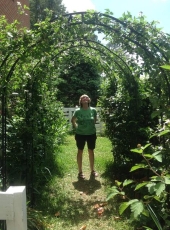I had a chance to survey 2.5 acres with a friend on Saturday. The ground was largely frozen solid and it had 6" of snow on top of it with snow pack in several areas.
The included images show
solid lines where we shot vectors and
dashed lines where the contour is implied based on water flow on the property. The orange line is the US topo map at 1080' which as you can see isn't accurate.

I learned so much from this experience and the next time I survey it will go faster, and I will likely have slightly better equipment.
This was my process.
1) Place tripod in SW corner (highest point) of property and level with bubble level.
2) Put rotary level in place and turn on; wait for it to start rotating.
3) Took a 10' measurement North off the property marker and placed my first flag.
4) Placed measuring stick level on flag and adjusted sensor to show level.
5) Found another point about 20' away which was level and planted flag.
6) Partner at flag one took a compass reading to the level measuring stick at flag 2 and then used a measuring wheel to get distance between the two points.
7) We would write down something like the following:
Contour 1 @ 3.55' from SW property marker 10' North to first flag
20' 94 degrees
22' 134 degrees
Contour 2 @ 4.55' from SW property marker 109' 97 degrees first flag
17' 351 degrees
23' 299 degrees
etc.
Notice the number 3.55 and 4.55, there were fractional feet markers of the sensor on the measuring stick.
8 ) To move to a new contour line 1' lower in elevation we raised the sensor 1' on the measuring stick and found a level location; marking it with a flag.
9) second person would then take a compass reading from fixed known point to the new flag and record it and distance.
10) rinse and repeat.
At some point you will not have visibility on the laser and you will be forced to move the laser to a new location. We did this three times to get the whole property covered.
11) move laser to new location following steps 1 and 2.
12) back track to a previous known elevation flag marker and set sensor on measuring stick as in step 4
13) Write a note such as the following:
Moved transit to new location B (mark on map) 4.55 previous level is now 3.2top
This "top" indicated the location of the pointer on the large dash as it was not on the measured side of the dash. It was for reference only.
14) Move sensor up and down ft' using new measurement on stick.
15) continue to gather points.
11x17 paper with the gridded map of property (10' grids following property lines, in future I will likely orient these to magnetic north for the site)

Screen capture of spreadsheet I had to create to get the lines into illustrator. You will notice a pixels column (which is in inches) and a degree column (which is what I would enter into the rotational field)
 Problems I ran into.
Problems I ran into.
1) The compass I used wasn't junk but it wasn't great. When I do this again I am going to bring a mini tripod or a monopod for the compass to help level it and it will be of higher quality.
2) Declination. You need to adjust all your gathered data after you entered it into a spreadsheet for declination of your site. This data should but up to date and not old as the maps can shift yearly!
3) Measurement wheel is not idea since you are dealing with slopes. Because of this it is also a good idea to print out a picture of your property with a grid overlaid at a known distance to help map flags as you go. This will serve to check for bad data.
4) It might help to have taken two measurements, one the day of and one the day after to make sure data was accurate. Once we got into a groove our data was more accurate and we were faster. Our early data had some issues I had to resolve using map data.
5) You can't map through obstructions! We had a lot of packed and iced over snow mounds we simply couldn't take a level reading on. You have to use your knowledge of the water flow on property to supplement this data and if necessary go back at a later day!
6) The bubble level on our measuring stick would accidentally get bumped at times, You must take your measurement when the stick is level!
7) Sometimes the sensor was bouncing between + / - and we simply marked that spot level instead of spending 10 minutes trying to find a spot 1mm to the left or right.
8 ) Our compass got "stuck" a couple of times. It is important to check your gear every time you take a measurement to make sure what you are recording is accurate. I am considering obtaining a Suunto inclinometer / compass for future survey use.
http://www.amazon.com/Inclinometer-Compass-Precision-Satellite-Measurement/dp/B005F7D1J0/ref=sr_1_sc_3?ie=UTF8&qid=1427124986&sr=8-3-spell&keywords=suunto+inclomometer+compass
If there is more interest in this I can do a better write up / videos and put them on my blog (which I haven't updated in a while) and post the content here.
Equipment used:
Johnson Level and Tool 40-6537 Self-Leveling Horizontal Rotary Laser Level
https://www.amazon.com/gp/product/B00372WJUW/ref=oh_aui_detailpage_o01_s01?ie=UTF8&psc=1
Military Prismatic Sighting Compass w/ Pouch
https://www.amazon.com/gp/product/B001ID4ZY0/ref=oh_aui_detailpage_o00_s00?ie=UTF8&psc=1
Calculated Industries, Inc 6540 Wheel Master Pro Measuring Wheel, 12.5-Inch Diameter Wheel
https://www.amazon.com/gp/product/B00LN74KK0/ref=oh_aui_detailpage_o00_s01?ie=UTF8&psc=1
2 of Empire Level 78-004 Stake Flags, Yellow
https://www.amazon.com/gp/product/B001DZEERQ/ref=oh_aui_detailpage_o00_s01?ie=UTF8&psc=1
Johnson Level and Tool 40-6350 Universal Tripod Kit
https://www.amazon.com/gp/product/B001OA1B1W/ref=oh_aui_detailpage_o01_s00?ie=UTF8&psc=1
 4
4











 1
1








 1
1









 1
1











